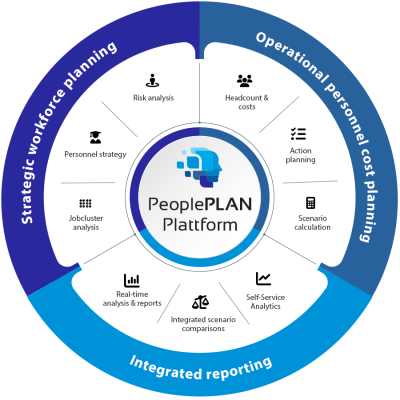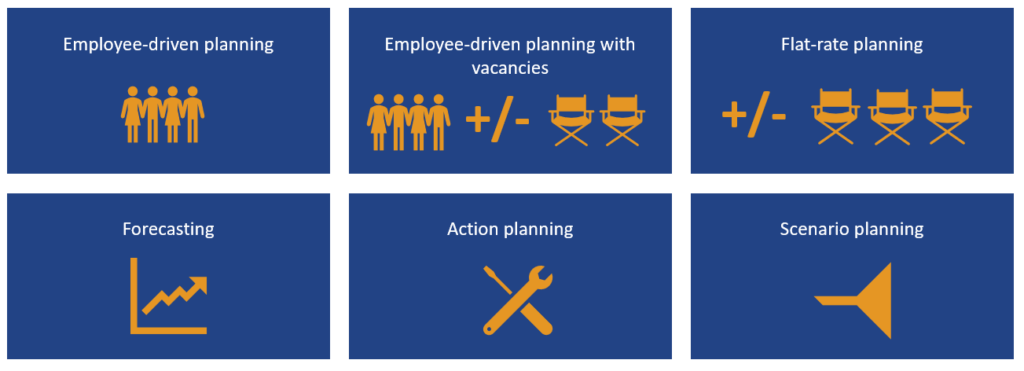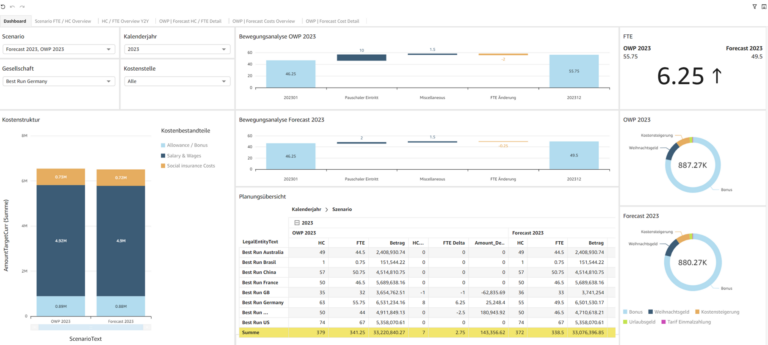Why is operational workforce planning important for your company?
Personnel costs are part of the company’s total costs. Their planning is the future-oriented management through personnel measures in personnel controlling.
The five most important reasons for using operational workforce planning are
- High share of personnel costs in total costs
- Securing competitiveness
- Preparation for changing market conditions
- Compliance with budgets and legal requirements
- Transparency and traceability with the aim of increasing efficiency
In addition to the operational forecast for the current year, medium-term planning with a longer-term view of two to five years also plays an important role. This is also referred to as operational workforce planning, which aims to make short and medium-term decisions.
Operational workforce planning differs from strategic workforce planning, which maps measures for long-term opportunities and risks over the next five to ten years.
What are the objectives of operational workforce planning?
Operational workforce planning helps companies to control costs, implement the objectives of their HR strategy and prepare for possible changes. It ensures that financial resources are used efficiently without jeopardizing competitiveness or employee satisfaction.
Nowadays, personnel costs are one of the main drivers of a company’s total costs. With a cost share of up to 70 % of total expenditure, their management should therefore have an extremely high priority in personnel management and controlling. Companies in high-wage countries such as Germany, Switzerland and Austria in particular are faced with the challenge of always being measured by the efficiency of their personnel in international competition.
Here, workforce planning is one of the decisive levers for being and remaining competitive.
However, the cost perspective is not the only decisive factor when it comes to the future-oriented management of personnel. The build-up and reduction of personnel capacities is also relevant for various areas of the company. Recruiting, for example, has a lead time of many months if a new position or even a new location is to be established. When reducing personnel, there are also many dependencies to consider, such as informing the works council or notice periods, so a certain lead time is crucial here.

In this webinar, you will learn how strategic HR planning can help you to identify bottlenecks and overcapacity in your personnel structure at an early stage and take proactive measures.
At a glance: operational workforce planning process
1. the planning preparation
Planning rounds, which are used to prepare every operational workforce plan, are usually carried out on an annual basis. However, in addition to annual planning, other planning periods can also play a role. For example, multi-year planning periods can be used for the development of new business areas, while smaller planning meetings and forecasts can be broken down to a monthly basis depending on the purpose.
Two different approaches are available for planning preparation:
Top-down method
With the top-down method, company management first sets cost targets and passes these on to the HR department. This approach can be implemented quickly and cost-effectively and enables very uniform planning – however, it can fail due to a lack of acceptance by employees and therefore a lack of implementation.
Bottom-up method
With the bottom-up method, coordination takes place between the HR department and management and is then passed on to the company management as a ready-made planning proposal. This approach ensures a high level of acceptance among employees, but also harbors the risk that different objectives of the planners may lead to contradictions and conflicts. In addition, the bottom-up method is more time-consuming and cost-intensive than the top-down method.
Mixed methods such as the so-called “counter-current method” can mitigate the contradictions between the two planning methods.
2. create the planning basis
Reliable operational workforce planning is based on real data. This is provided by the evaluation of payroll accounting and is also defined by the number of employees and the organizational classification of employees.
The data required for precise operational workforce planning includes, for example, the basic employee salary, social security contributions, taxes and foreseeable special payments. However, rate tables, pay scale groups, employee turnover data and information on organizational units, jobs and positions are also used to determine a broad database.
The success of meaningful operational workforce planning always depends on the quality of the underlying data – it is therefore particularly important that the planning basis is always broadly based on as much personnel data as possible available in the systems.
3. consider influencing factors and changes
When initiating operational workforce planning, particular attention must be paid to the fact that many factors can influence the level of monthly personnel costs. Personnel costs therefore never develop in a straight line.
In order to take this into account in operational workforce planning, both company-specific and external factors influencing personnel costs must be considered and included in the planning:
Company-specific influencing factors
For operational workforce planning, the development of absenteeism, fluctuations in employment, internal staffing policy, frequent restructuring or the influence of the works council can be important planning variables to consider. Company incentive systems, training costs and the company’s recruitment policy are also among these company-specific influencing factors.
External influencing factors
External factors such as collective wage agreements, changes to tax and duty laws, but also general economic fluctuations and the competitive situation on the labor market have a considerable influence on the precision of operational workforce planning and must therefore already be included in the planning basis.
4. simulation of various cost planning scenarios
The real data obtained for operational workforce planning can now be used, taking into account the identified influencing factors, to run through various planning scenarios and derive a risk-benefit analysis from the results obtained.
The detailed level of cost planning can be broken down to individual employees, jobs and positions – but planning scenarios can also be simulated at company and department level.
The scope for action identified by the planning scenarios always requires additional interpretation in order to be able to make final decisions. For example, in addition to the pure planning figures, the impact on employee motivation of a measure and the resulting degree of employee overload or underutilization should always be included in the interpretation of a planning scenario.
Examples of this include the simulation of a salary increase versus a target agreement with a variable remuneration component or the simulation of various scenarios in which the overtime of existing employees is compared with the recruitment of additional employees.
If this is taken into account, operational workforce planning provides valuable new insights that not only enable the company to make cost savings, but also to develop a better personnel strategy.
5. create planning data from projections
In order to be able to generate planning data in operational workforce planning in a targeted manner, the granularity with which the data is to be extrapolated must first be determined.
Two approaches with different advantages are available for this purpose:
Rough calculation of costs and headcount
Rough calculation enables quick statements to be made on the effects of individual personnel parameters on the cost situation. Rough Calculation of costs and headcount can be used, for example, to present and analyze short-term changes in the influencing variables.
Refined calculation
Refined calculation, on the other hand, is particularly suitable for longer-term planning rounds, such as for basic annual planning. This refined calculation is more detailed, more time-consuming and provides a more comprehensive picture.
6. review of the planning scenarios
The findings for operational workforce planning that result from running through different scenarios, from various projections, from the consideration of internal and external influencing factors and from the company-specific requirements are first subjected to a thorough review before completion.
Such an additional discussion of the results and findings is particularly important to ensure that the final decision between different options resulting from the operational workforce planning is actually in line with the strategic direction of the internal decisions.
7. decision on the planning results
The final decision within the operational workforce planning process chain often requires more than just one planning round. This ensures that the final decision is as sustainable as possible within the company structure.
8 Accompanying controlling
A controlling process that accompanies the implementation of the planned measures should always be part of any well-founded operational workforce planning.
In this context, “controlling” does not only mean a target/actual comparison of whether planned figures are exceeded or not achieved. Rather, as part of workforce planning controlling, regular checks should also be carried out to determine whether, for example, influencing factors (internal/external) have changed and whether and how previously defined personnel management indicators reveal deviations from the planned targets.
Controlling concludes the process chain. It ensures that risks are identified in good time and countermeasures can be introduced in good time to secure the long-term success of the company, which can be achieved through successful operational workforce planning
What methods of operational workforce planning are there?
When carrying out operational workforce planning, it is generally recommended to carry out employee-driven planning. This has the advantage that operational workforce planning is as accurate as possible and the actual values from the operational payroll accounting system are used as the basis for planning.
When recruiting new employees, it is not possible to assume only actual employees, as only positions exist for this purpose. However, the cost structure of existing employees can be used as a template for planning. However, you would use planning based on exact employee costs where they exist. In this case, we are dealing with employee-based planning in combination with planning with vacancies.
When setting up new locations and business units, you can also plan completely across the board. This means that you only plan positions based on experience. This is also possible for staff reductions in the planning process. This is referred to as flat-rate planning.
Forecasting provides operational support for personnel controlling over the course of the year in order to achieve agreed targets and manage them proactively. Rolling operational workforce planning is often used for this purpose, where planning is carried out at regular intervals, e.g. once a quarter.
Personnel controlling uses action planning for management purposes. Measures can be
- Structure
- Reduction in the workforce
- Change in working hours
- Parental leave
- Retirement
- and many more
Once the action planning has been completed, there is often more than one plan. This can be used as a basis for deciding which of these plans is more favorable, more realistic or more effective. The comparison of these different forecasts is called scenario planning.
Key figures for operational workforce planning
The most important key figures in operational workforce planning are listed below:
- Plan deviation of personnel costs: describes the extent to which actual costs deviate from the planned personnel cost development.
Formula: (Actual costs – Planned costs) / Planned costs × 100. - Personnel cost growth rate: percentage increase or reduction in personnel costs over a certain period of time.
Formula: (personnel costs in the current year – personnel costs in the previous year) / personnel costs in the previous year × 100.
The headcount bridge is also an important analysis tool that goes beyond individual key figures. It graphically displays the changes in the number of employees (headcount) to make them easier to understand.
Other key figures that are relevant in connection with operational workforce planning are listed below:
- Personnel cost ratio: share of personnel costs in total operating costs or sales.
- Employee structure by cost: distribution of personnel costs across different employee groups (e.g. departments, qualification level, full-time/part-time).
Example of operational workforce planning (incl. Excel template)
In practice, every company faces daily changes, because here too, “nothing is as constant as change”.
Corporate changes, such as the opening of a new plant with new production employees, have a direct influence on personnel planning. However, external factors such as inflation also have a significant influence on the expectations of existing and new employees regarding salary increases.
The following applications occur frequently in practice:
- Establishment of a new R&D department with 12 new employees in Romania.
- In addition to the employee wages applicable there, a cost increase of 8% is assumed
- Operational workforce planning calculates the additional wage costs, including ancillary wage costs, to be expected here.
- Scenario 1: Planning with premium distribution
- Scenario 2: Planning without premium distribution
- A comparison of the premiums shows the potential operating cost savings
3. example: job cuts
- Job cuts of 300 employees in connection with the closure of a chemical plant in the following year
- The calculation is used to calculate the potential cost savings from personnel costs
These examples are by no means exhaustive.
In operational workforce planning, smaller and more complex changes are also planned, such as retirements, which in turn can result in a new build-up for replacement. Measures such as short-time working also frequently occur in planning practice. Operational workforce planning is used to estimate the cost-related consequences as accurately as possible and to derive a concrete decision.

Download our free Excel template for creating a personnel cost plan here
Common mistakes in operational workforce planning
The more complex a company is, the more complex its operational workforce planning will generally be.
A common mistake is therefore inaccurate planning due to flat-rate planning assumptions. This leads to serious misjudgements and ultimately to wrong decisions in personnel management.
While pure Excel planning can be sufficient for companies with up to 100 employees, it becomes difficult when the number continues to grow, different locations are involved and these locations are also in different countries.
The complexity of the different wage structures and non-wage labor costs often leads to simplifications in Excel lists that have a significant negative impact on the planning result.
Another common mistake is the speed of the planning processes. Some planning rounds take several weeks because planning is an iterative process and data has to be sent back and forth. However, this is not only highly questionable for data protection reasons, but also severely restricts the ability to act and make decisions. Incidentally, this process is also inefficient because it ties up resources.
The data quality of the data used as a basis for planning is also often incomplete or abbreviated. This is the case, for example, when flat-rate costs are used for planning if there is no link to the data from payroll accounting.
Only those employees should have access to employee-related data who are authorized to do so. For example, financial controlling has a view of personnel costs by cost center, but employee-related wages and salaries are subject solely to the control of the HR departments. When processing Excel lists, this differentiation is sometimes very difficult to implement and therefore poses a risk to data protection.
Software for operational workforce planning
For Enterprise companies
Enterprise companies are not only distinguished from SMEs by the size of their total assets and number of employees. They are also characterized by decentralized locations, different currencies, different legal regulations and different languages. This makes it all the more important to have a central planning tool that can be used for decentralized and authorization-controlled planning.
Many large companies use SAP HR systems such as SAP HCM, SAP H4S4 or SAP SuccessFactors. These systems take currencies, languages and other location-specific features into account perfectly and precisely. This connection is ideal for taking existing HR data into account during planning. The connection is possible through the use of standard interfaces.
The PeoplePLAN software allows payroll data and HR master data to be connected via interfaces. At the same time, however, payroll data can also be provided simply via Excel import. This is the case, for example, if an individual national company uses a completely different HR system.
For the SME sector
Medium-sized companies very often have several locations – and often internationally. The sheer number of employees may be less than in large companies, but the complexity of the planning is certainly not.
Here too, it is advisable to obtain existing plan data directly from the operational HR systems. In addition to SAP HCM, SAP SuccessFactors or SAP H4S4, this can also be a Personio system or a connection via an Excel import.
The PeoplePLAN software offers such planning, which is suitable for both decentralized and centralized planning and allows business units to be planned separately with precise data.
For small companies
For smaller companies with fewer than 100 employees, it offers immense added value if they carry out operational workforce planning. However, it may be sufficient to carry out personnel cost planning in Excel, as the complexity is manageable and generally does not involve any additional costs.
You can get your free Excel template here.

Take advantage of our consulting service and make an appointment with our experts for strategic personnel planning, operational workforce planning and integrated reporting. We look forward to hearing from you.
Operational operational workforce planning can be simple, integrated and fast.
With PeoplePLAN, you can project personnel capacities and costs in just a few seconds and compare different scenarios. You plan the measures your company needs to be competitive in the coming years and make sustainable, transparent decisions.
With the PeoplePLAN platform, operational operational workforce planning is directly linked to your reporting and strategic personnel planning.
Just try it out for 14 days free of charge: Test it now










